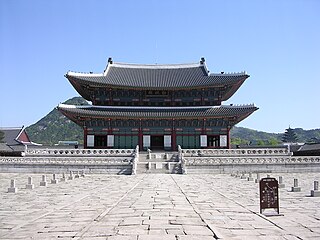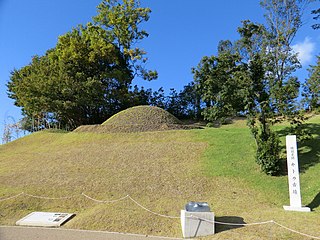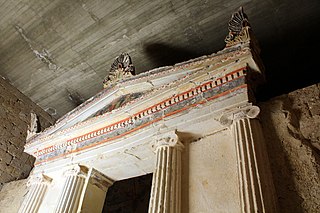Related Research Articles

KV62 is the standard Egyptological designation for the tomb of young pharaoh Tutankhamun in the Valley of the Kings, now renowned for the wealth of valuable antiquities that it contained. Howard Carter discovered it in 1922 underneath the remains of workmen's huts built during the Ramesside Period; this explains why it was largely spared the desecration and tomb clearances at the end of the 20th Dynasty, although it was robbed and resealed twice in the period after its completion.

The Seokguram Grotto is a hermitage and part of the Bulguksa temple complex. It lies four kilometers east of the temple on Mt. Tohamsan, in Gyeongju, South Korea. It is classified as National Treasure No. 24 by the South Korean government and is located at 994, Jinhyeon-dong, Gyeongju-si, Gyeongsanbuk-do. The grotto overlooks the Sea of Japan and rests 750 meters above sea level. In 1962, it was designated the 24th national treasure of Korea. In 1995, Seokguram was added to the UNESCO World Heritage List together with the Bulguksa Temple. It exemplifies some of the best Buddhist sculptures in the world.

A gallery grave is a form of megalithic tomb built primarily during the Neolithic Age in Europe in which the main gallery of the tomb is entered without first passing through an antechamber or hallway. There are at least four major types of gallery grave, and they may be covered with an earthen mound or rock mound.

Korean architecture refers to an architectural style that developed over centuries in Korea. Ever since the immigration of people originating from Siberia and Manchuria, Korea had kept an influence of Chinese architecture in the works because of close relations.

QV66 is the tomb of Nefertari, the Great Wife of Pharaoh Ramesses II, in Egypt's Valley of the Queens. It was discovered by Ernesto Schiaparelli in 1904. It is called the Sistine Chapel of Ancient Egypt. Nefertari, which means "beautiful companion", was Ramesses II's favorite wife; he went out of his way to make this obvious, referring to her as "the one for whom the sun shines" in his writings, built the Temple of Hathor to idolize her as a deity, and commissioned portraiture wall paintings. In the Valley of the Queens, Nefertari's tomb once held the mummified body and representative symbolisms of her, like what most Egyptian tombs consisted of. Now, everything had been looted except for two thirds of the 5,200 square feet of wall paintings. For what still remains, these wall paintings characterized Nefertari's character. Her face was given a lot of attention to emphasize her beauty, especially the shape of her eyes, the blush of her cheeks, and her eyebrows. Some paintings were full of lines and color of red, blue, yellow, and green that portrayed exquisite directions to navigating through the afterlife to paradise.

Tomb KV43 is the tomb of Pharaoh Thutmose IV in the Valley of the Kings in Luxor, Egypt. It has a dog-leg shape, typical of the layout of early 18th Dynasty tombs. KV43 was rediscovered in 1903 by Howard Carter on behalf of Theodore M. Davis.

The Kitora Tomb is an ancient tumulus located in the village of Asuka, Nara Prefecture, Japan. The tomb is believed to have been constructed some time between the 7th and early 8th centuries, but was only discovered in 1983.

The Pyramid of Khendjer was a pyramid built for the burial of the 13th dynasty pharaoh Khendjer, who ruled Egypt c. 1760 BC during the Second Intermediate Period. The pyramid, which is part of larger complex comprising a mortuary temple, a chapel, two enclosure walls and a subsidiary pyramid, originally stood around 37 m (121 ft) high and is now completely ruined. The pyramidion was discovered during excavations under the direction of Gustave Jéquier in 1929, indicating that the pyramid was finished during Khendjer's lifetime. It is the only pyramid known to have been completed during the 13th Dynasty.

The Tomb of King Muryeong, also known as Songsan-ri Tomb No. 7, is the ancient tumulus of King Muryeong, who ruled the Baekje from 501 to 523, and his queen. The rarity of intact Baekje tombs makes this one of the major archaeological discoveries in Korea and a crucial source for the understanding of Baekje, one of the Three Kingdoms of Korea.

The Saadian Tombs are a historic royal necropolis in Marrakesh, Morocco, located on the south side of the Kasbah Mosque, inside the royal kasbah (citadel) district of the city. They date to the time of the Saadian dynasty and in particular to the reign of Ahmad al-Mansur (1578–1603), though members of Morocco's monarchy continued to be buried here for a time afterwards. The complex is regarded by many art historians as the high point of Moroccan architecture in the Saadian period due to its luxurious decoration and careful interior design. Today the site is a major tourist attraction in Marrakesh.

The Tomb of King Tongmyŏng is a mausoleum located in near Ryongsan-ri, Ryŏkp'o-guyŏk, P'yŏng'yang, North Korea. One of the tombs is the royal tomb of Tongmyŏng, the founder of the ancient Goguryeo kingdom, northernmost of the Three Kingdoms of Korea. In total, there are 63 individual tombs of the period. The area around the Tongmyong contains at least fifteen known tombs believed to belong to various vassal lords. The tomb has achieved World Heritage status as part of the Complex of Goguryeo Tombs inscribed by UNESCO in 2004 under Criteria (i), (ii), (iii) and (iv) covering an area of 233 hectares with a buffer zone of 1,701 hectares. A unique feature of this and the other extant tombs in the area are its wall paintings depicting lotuses blossoming of that period indicative of Buddhism practiced in Korea.

The Illyrian Tombs of Selca e Poshtme are located near the town of Pogradec in Albania near the village of Selcë e Poshtme. On the right bank of the river Shkumbin at an elevation of 1040 m above sea level, lie the remains of the ancient city of Pelion and the accompanying necropolis. The Roman Via Egnatia led past it towards Thessaloniki. Though there are traces of human activity in Neolithic times, the settlement proper dates to the Iron Age through to the Illyrian urban period, and reached its height under settlement by the Illyrian tribe of Enchele in the later Iron Age and was also occupied in the Roman period as traces of a municipal building show. From the 4th to 1st centuries BC the city was the royal residence of Illyrian kings and therefore, also probably an important political and economic centre. In 1996, Albania included the Royal tombs of Selca e Poshtme in the UNESCO World heritage list of proposals.

The Aleksandrovo tomb is a Thracian burial mound and tomb excavated near Aleksandrovo, Haskovo Province, South-Eastern Bulgaria, dated to c. 4th century BCE.

The Thracian tomb "Helvetia" mound near Shipka, Bulgaria, was built in the middle of the 4th century BC.

The Valley of the Thracian Rulers is a popular name which was made public by the archaeologist Georgi Kitov and describes the extremely high concentration and variety of monuments of the Thracian culture in the Kazanlak Valley. It is believed that there are over 1500 tumuli in the region, with only 300 being researched so far.

The Tomb of Hunting and Fishing, formerly known as the Tomb of the Hunter, is an Etruscan tomb in the Necropolis of Monterozzi near Tarquinia, Italy. It was discovered in 1873 and has been dated variously to about 530–520 BC, 520 BC, 510 BC or 510–500 BC. Stephan Steingräber calls it "unquestionably one of the most beautiful and original of the Tarquinian tombs from the Late Archaic period." R. Ross Holloway emphasizes the reduction of humans to small figures in a large natural environment. There were no precedents for this in Ancient Greek art or in the Etruscan art it influenced. It was a major development in the history of ancient painting.

In the middle of the 19th century, an important Macedonian tomb, now known as Tomb A, was discovered near the Greek village of Korinos. In 1991 a second, smaller grave was discovered and excavated.

The Tomb of Judgement, also known as the Great Tomb of Lefkadia is an ancient Macedonian tomb of the Hellenistic period in Mieza, noted for its monumental painted facade. It was probably built at the beginning of the third century BC.

The Tomb of the Palmettes, sometimes known as the Rhomiopoulou Tomb, is an ancient Macedonian tomb of the Hellenistic period in Mieza, noted for the quality of its painted decoration. It was built in the first half of the third century BC.
The Tomb of Macridy Bey (Greek: Τάφος Μακρίδη Μπέη, romanized: tafos makridi bei, also known as the Tomb of Langadas, is an ancient Macedonian tomb of the Classical or early Hellenistic period, on the site of ancient Lete, modern Derveni between Thessaloniki and Langadas, in Central Macedonia, Greece. A number of cist graves and a single chamber tomb are located in the vicinity. The structure seems to date to the late fourth or early third century BCE.
References
- ↑ Yang-mo Chŏng; Judith G. Smith, eds. (1998). Arts of Korea. New York: Metropolitan Museum of Art. p. see page 296. ISBN 0870998501 . Retrieved October 8, 2014.
- ↑ Macouin, Francis (1987). "Aux origines de l'hypocauste coréen (ondol)" [The origins of the Korean hypocaust (Ondol)]. Arts Asiatiques (in French). 42 (42): 77–88. doi:10.3406/arasi.1987.1218.
- ↑ "Yaksu-ri Tomb". Inter-Korea Historical Assoc. Retrieved November 15, 2014.
| This article about a North Korean building or structure is a stub. You can help Wikipedia by expanding it. |